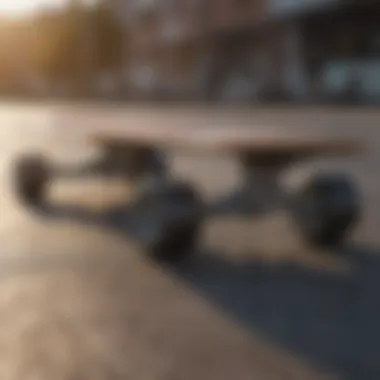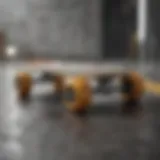Analyzing the Skateboard Market: Trends and Insights


Intro
Skateboarding is more than just a pastime; it has evolved into a cultural phenomenon that captivates enthusiasts around the globe. From the iconic image of youth gliding effortlessly down streets to the adrenaline-pumping tricks seen in competitions, skateboarding encompasses a diverse array of styles and practices. As the landscape of skateboarding continues to shift, it's vital for consumers and practitioners alike to navigate the expansive market effectively. This journey begins with understanding the equipment and gear essential for the sport.
Equipment and Gear
When it comes to skateboarding, having the right equipment can make or break the experience. Whether you’re a beginner or a seasoned pro, gear serves not only as a protective measure but also as a personal statement. Let’s break down some key components.
Essential Gear Overview
Every skater should consider these basics:
- Skateboard Deck: The board itself comes in various shapes and sizes, catering to different styles such as street, park, or downhill skating.
- Trucks: The metal parts that connect wheels to the board, adjustable for turning and balance.
- Wheels: These come in different durometers, affecting the ride and grip. Softer wheels offer a smoother ride on rough surfaces, while harder ones are better for tricks.
- Bearings: Good bearings can vastly improve glide and speed, thus they shouldn't be ignored.
- Protective Gear: Helmets, knee pads, and elbow pads are crucial to ensuring safety while enjoying the thrill of skating.
Top Brands and Recommended Products
Diving deeper into brands, some names stand out in the skateboarding community:
- Element: Known for their durable decks, ideal for both street and park skating.
- Santa Cruz: A historical player, they offer a range of designs suitable for all skill levels.
- Independent: Their trucks are among the most trusted by pros for their strength and reliability.
- Bones: Famed for their high-quality bearings, they ensure your wheels can reach incredible speeds with minimal friction.
Maintenance Tips
Regular maintenance applies not just to maximizing performance, but also to prolonging the life of your skateboard. Here are some essential tips:
- Clean Wheels and Bearings: Dirt can accumulate quickly. Clean them using a cloth and some specific skateboard cleaner regularly.
- Check for Cracks or Splits: Inspect your board frequently for any signs of damage that could result in injury.
- Upgrade Components as Needed: Don’t hesitate to switch out worn-out parts for new ones. This keeps your setup fresh and performance high.
Techniques and Training
Mastering skateboarding isn’t just about having the right gear—technique plays a massive role. From basic tricks to advanced maneuvers, continuous training is key.
Advanced Skills Breakdown
Skateboarding involves a repertoire of tricks that varies between styles; however, some basics underpin the craft:
- Ollie: A foundational trick for jumping obstacles, and a building block for much more.
- Kickflip: Incorporating a spin as you jump, this trick impressively showcases aerial creativity.
- Grinds: These require finesse and practice, balancing on rails or ledges.
Training Exercises
Athletes can enhance their skills through specific exercises:
- Balance Training: Use a balance board or exercise ball to improve stability.
- Leg Strength Workouts: Squats and lunges can develop the essential leg power that skaters rely on.
Safety and Risk Management
Engaging in skateboarding without proper precautions can lead to unfortunate accidents. Understanding and implementing safety protocols is crucial for everyone.
Importance of Safety Protocols
Using protective gear helps reduce the risk of injury significantly. These measures aren't just for beginners. Experienced skaters are also susceptible to falls and should remain attentive to their safety.
Common Risks
Some hazards that skaters might encounter include:
- Poorly maintained surfaces that could cause slips.
- Overestimating skills, leading to injuries from more complex tricks.
Mitigation Strategies
To prepare for the unexpected:
- Know Your Limits: Stick to challenges that suit your current level and experience.
- Learn to Fall Safely: Falling is part of the learning process. Practice rolling when you hit the ground to minimize impact.
Lifestyle and Community
Skateboarding intertwines deeply with community culture and lifestyle choices.
Lifestyle Aspects
For many, skating is not just a sport; it shapes how they connect with others. Skaters often find camaraderie in local skate parks or competitions, forming friendships built on shared passions.
Balancing Sport with Well-Being
Surviving the adrenaline rush requires balance. It’s essential to prioritize health, both physically and mentally, while chasing the next thrill. Regular downtime and recovery play a part in long-term success.
"Skateboarding is a way to find yourself through movement. Every trick, fall, success, and failure is a chapter in your story."
Closure
Understanding the plethora of elements surrounding the skateboard market allows enthusiasts to appreciate it on deeper levels. By making informed decisions about gear, prioritizing safety, and immersing in the community, skaters can enhance their overall experience in this vibrant sport.
Understanding Skateboard Types
When it comes to choosing the right skateboard, understanding the different types available is crucial. Each style caters to specific riding preferences and skill levels. Whether you’re carving through a city, cruising down a boardwalk, or hitting ramps at a skate park, knowing what type of skateboard suits your needs can make a world of difference. The skateboard market is vast, with options to fit every flavor and skill set, and knowing the nuances of each can help you ride like you mean it.
Standard Skateboards


Standard skateboards, often referred to as street boards, are the most common type seen in skate parks and urban settings. They typically have a shorter deck, around 28 to 32 inches long, which makes them agile for tricks and maneuvers. The width usually ranges from 7.5 to 8.5 inches, giving riders a comfortable ride while allowing for a decent platform for tricks.
The design features a concave shape that helps with foot placement, enabling riders to pop tricks more effectively. Standard skateboards are particularly well-suited for tricks like ollies, kickflips, and grinds. Additionally, they are lightweight, making it easier for skaters to perform aerial feats. For beginners, a standard skateboard can be a go-to choice, providing a solid foundation to get started.
Longboards
Longboards are the choice for those seeking stability and smooth rides over longer distances. Typically between 33 to 59 inches in length, these boards offer a different feel compared to their shorter counterparts. The extended length helps in maintaining balance, making them ideal for downhill runs or cruising in open spaces.
These boards often feature larger wheels, which translate to a smoother ride over rough terrain. Longboards can have different shapes, like pintail or drop-through, each affecting the riding style. For those who enjoy carving on slopes or just want to roll smoothly through the streets, longboards provide a more relaxed experience than a traditional skateboard.
Cruisers
Cruiser skateboards sit somewhere between standard skateboards and longboards in terms of size and purpose. Usually around 28 to 34 inches long, cruisers are designed for rolling comfort and ease of use. They are perfect for getting around town and navigating city streets, often featuring soft wheels that absorb bumps in the road nicely.
Cruisers often come with a variety of deck shapes, including surf-style designs that allow for tight turns. They may not be the best for doing tricks, but you can still have some fun with them just going around. Perfect for those who prefer a laid-back riding style, cruisers are ideal for casual skaters and commuters.
Electric Skateboards
In recent years, electric skateboards have surged in popularity, offering an entirely new dimension to skateboarding. These boards are equipped with electric motors that enable riders to cruise at higher speeds without intense physical effort. The battery life on these boards can vary greatly, often determining how far you can travel on a single charge.
Electric skateboards come in various designs, ranging from those resembling standard skateboards to longboards. They are particularly attractive to commuters, as they can cover greater distances without breaking a sweat. However, they demand a little more attention in terms of weight distribution and maneuvering. Riders must also pay attention to local laws, as the regulations for electric skateboards can differ greatly from traditional skateboards.
"Understanding the different types of skateboards can enhance the riding experience, ensuring that every skater finds the perfect fit for their style and skill level."
Overall, the variety of skateboards available offers something for everyone, whether it’s the nimble maneuverability of standard boards, the stability of longboards, the casual vibe of cruisers, or the high-tech appeal of electric models. Choosing the right skateboard isn’t just a matter of taste; it’s about aligning your choice with how you want to ride.
Key Features to Consider
When venturing into the skateboard market, it's not just a matter of picking something off the shelf. Key features warrant a careful consideration, as they play a critical role in the overall performance, safety, and enjoyment of the ride. Whether you’re a seasoned pro or just starting out, each skateboard element contributes to how it suits your personal style and needs. Below, we’ll delve into the fundamental aspects of skateboard design that can enhance your ride.
Deck Material and Shape
The deck of a skateboard is essentially its backbone. The materials used not only affect its durability but also impact how well it stiffens and responds during tricks. Common materials include maple, which offers a good balance between weight and flexibility. Some opting for a lightweight option might gravitate towards decks crafted from bamboo, which brings a unique combination of long-lasting durability and slightly enhanced shock absorption.
Shapes, too, can vary widely. Skateboards typically come in standard shapes or with various concave profiles. A deeper concave facilitates easier control and allows for more aggressive tricks. The wider decks, great for stability, are particularly favored by those leaning towards street skating. Embracing the right material and shape can significantly change how the board maneuvers, making it essential for the rider to choose wisely based on their skating style and goals.
Wheel Size and Hardness
When it comes to wheeling away, the size and hardness of your skateboard wheels are pivotal. Larger wheels, around 55mm and above, are typically referred to as cruiser wheels, providing a smoother ride, especially on rough terrain. On the flip side, smaller wheels, usually in the 50mm range, are standard for tricks and street skating, as they offer more responsiveness.
As for hardness, it’s indicated by ‘durometer’ ratings. Softer wheels (78A to 87A) work wonders on rough surfaces by absorbing more shocks, while harder wheels (88A and above) are preferable for smooth skate parks and technical street tricks. Finding a balance that suits the terrain and the rider’s style enhances both speed and control.
Trucks and Bearings
Trucks serve as the bridge between the deck and wheels, dictating the skateboard’s turning abilities and stability. Typically crafted from aluminum, they come in various widths. The right truck width should align with the skateboard deck width for optimal stability and performance.
Bearings, on the other hand, affect how smoothly the wheels turn. The rating of bearings is often defined by the ABEC scale; higher ABEC ratings mean better precision manufacturing, allowing for a faster ride. However, it’s essential to note that great bearings paired with poor trucks or wheels can lead to suboptimal performance. Skaters should consider the type of skating they plan to do and pick bearings that can hold up during high-impact maneuvers.
Grip Tape Quality
Grip tape is both an aesthetic choice and a functional necessity. Made predominantly from sandpaper-like material, it’s applied on top of the skateboard deck to maximize traction. The quality of grip tape is critical— a rough texture offers better grip, while lower quality can wear down quickly, leading to unwanted slips.
The diversity in grip tape designs allows for personalization, not only making the board uniquely yours but also providing a better grip that aligns with trick styles. Remember, a solid grip is the foundation for executing skate tricks flawlessly, so investing in good quality grip tape will pay off in long-lasting performance on the streets or in parks.
Key takeaway: The right blend of deck material, wheel size, truck quality, and grip tape can hugely affect not just performance, but the overall enjoyment of skateboarding.
Choosing the right skateboard isn’t just about aesthetics; it’s about enhancing the experience, safety, and skills. Understanding these features opens the door to a more informed purchase, allowing riders to connect better with their gear.
Buying Guidelines for Skateboards
Navigating the skateboard market can be as tricky as mastering an ollie. With so many types, brands, and features, knowing where to start can feel overwhelming. This section aims to equip you with essential guidelines to make informed choices about skateboards. By understanding your unique needs, you’ll be better positioned to select a skateboard that not only suits your skate style but also fits within your budget.
Determining Your Skill Level
Before even stepping foot into a shop or clicking through websites, take a moment to assess your skill level. Are you an absolute beginner, or are you casually cruising or perhaps shredding ramps? Understanding where you stand will significantly influence your choices.
- Beginners often benefit from a well-rounded skateboard that provides stability. Look for a wider deck and softer wheels for smoother rides.
- Intermediate and advanced skaters might prefer specialized boards tailored to their style, perhaps a narrower setup for tricks or a longer one for downhill rides. Knowing what you can handle and what feels right beneath your feet can make a world of difference.
Budgeting for Your Purchase
Money talks, and in the skateboard market, it can make or break your experience. Setting a clear budget is crucial.
- Entry-level boards typically range from $50 to $100. These are perfect for beginners wanting to dip their toes into skating.
- Mid-range options, priced between $100 and $300, usually provide better quality and longevity for those who skate regularly.
- Investing over $300 can unlock professional-grade boards designed for hardcore enthusiasts. However, such purchases should be approached with caution, especially if you’re still honing your skills.
Budgeting wisely prevents wallet pain later on, allowing you to enjoy the sport without financial worries hanging over your head.
Where to Buy Skateboards
Once you’ve gauged your skill level and set your budget, the next step is figuring out where to buy your board. Each option has unique strengths.
Online Retailers
Online shopping is often the go-to choice for many enthusiasts. With a few clicks, you can access a world of options.
- Key characteristic: A vast selection of brands and models you may not find in local shops. This diversity can lead you to stumble upon the perfect board for your style.
- Unique feature: Online retailers often give you access to customer reviews, which can be insightful. However, don’t forget to check the return policies. If the pair of wheels doesn't fit your vibe, you'll want that option.


It's convenient, but account for shipping times and costs. You may have to wait a bit longer to get on that board.
Local Skate Shops
There's something special about a local skate shop. Visiting one often means chatting with knowledgeable staff who are just as passionate about the sport.
- Key characteristic: A personalized shopping experience that allows you to physically test out boards and see them up close.
- Unique feature: Local shops sometimes host community events or skate sessions, providing an avenue to connect with fellow enthusiasts.
However, their stock might be limited compared to the vast world online. It’s the trade-off of having that local flavor against variety.
Secondhand Markets
Shopping in secondhand markets can be an adventure, tinged with surprises.
- Key characteristic: Affordability is a huge draw. You can often find great deals if you know where to look.
- Unique feature: Many seasoned skaters sell their old boards as they upgrade, which can mean getting a top-notch setup without the hefty price tag of a brand new one.
On the flip side, buyer beware; always inspect items thoroughly to avoid snagging something that’s best suited for the trash bin instead of the pavement.
"In the world of skateboarding, your board is an extension of you. Choosing wisely means not just considering price or style but understanding your personal skate journey."
By delving into these buying guidelines, skaters can approach their purchasing decision with confidence and clarity. Whether you choose to buy online, hit up your local shop, or venture into the secondhand market, knowing what you need and what’s available will make all the difference in your skating experience.
Trends in Skateboard Design
In the world of skateboarding, design trends are not just about aesthetics; they play a significant role in enhancing performance, sustainability, and overall user experience. As the landscape of skateboarding continues to evolve, understanding these trends becomes essential for skaters looking to choose their gear wisely. Market shifts toward efficiency and individual expression shape how boards look, feel, and ride. Identifying these trends can help consumers make informed decisions, ensuring they pick the right skateboard that aligns not just with their personal style but also their values and performance needs.
Sustainable Materials
With increasing environmental awareness, more skateboard manufacturers are leaning toward sustainable materials. This shift not only appeals to eco-conscious riders but also enhances the durability of the boards. Brands are now exploring everything from bamboo to recycled plastics as viable alternatives to traditional wood, which is often sourced unsustainably.
- Benefits of Sustainable Materials:
- Eco-friendly options reduce environmental impact.
- Often more durable due to advanced material sciences.
- Can lead to lighter boards while maintaining strength.
Many skateboarders might not realize that using materials like a composite of recycled wood and eco-resins can help preserve forests and promote responsible sourcing. In a world where every choice counts, the trend towards sustainability isn't just a passing fad; it's a fundamental shift in how skaters view their relationship with the environment and the products they use.
Technological Innovations
The skateboarding industry is not lagging behind in the tech race either.Boards are being fitted with cutting-edge innovations that enhance performance and rider safety. Innovations such as shock-absorbing systems, enhanced grip tape technology, and even integrated LED lighting systems are becoming more common.
- Examples of Technological Advancements:
- Shock-absorbing suspensions improve comfort on uneven surfaces.
- Smart boards with built-in sensors track performance metrics.
- LED lights for visibility during night rides—a boon for safety.
These advancements are crucial, especially for urban riders who need their boards to withstand rough terrains. By embracing these technologies, skateboarders can elevate their riding experience, gaining access to features that can prevent injuries and enhance their overall performance.
Customization Options
Gone are the days when skateboards meant settling for what was available on the shelf. Customization has taken center stage in skateboard design. Riders now demand the ability to personalize everything from wheel sizes to deck shapes, allowing them to tailor their boards to match their skating style and preferences.
- Customization Options Might Include:
- Artwork and graphics that reflect personal style.
- Choice of board materials based on riding style and conditions.
- Adjustable components such as trucks for tailored stability or maneuverability.
This trend emphasizes the relationship between identity and sport. For many skateboarding isn’t just a pastime; it's a part of their lifestyle. Offering customization not only aligns with riders’ desires for personal expression but also enhances their connection to the sport, making it more meaningful.
"In every curve, in every graphic, a skater finds a part of themselves—making each board a reflection of unique identity."
As designers continue to innovate in this space, the blend of technology and individual expression is likely to deepen. With each creative twist and technological upgrade, skateboard design is not just evolving; it's transforming the skating experience entirely.
The Cultural Impact of Skateboarding
Skateboarding has morphed from a quirky pastime to a powerful cultural phenomenon that transcends generations. It's more than just riding a board; it’s about freedom, creativity, and community. The cultural impact of skateboarding is multidimensional, touching everything from music and fashion to social movements and community building. This section unpacks these facets, shedding light on why skateboarding holds a significant place in modern culture.
Skateboarding in Popular Media
This phenomenon didn't just spring from the concrete parks; it’s painted across screens and stages in diverse forms. Films like Dogtown and Z-Boys and The Lords of Dogtown have chronicled the lifestyle and evolution of skate culture, elevating it from niche interest to mainstream obsession. Then there's the Tony Hawk's Pro Skater video game series, which invited countless kids to embrace skateboard culture, regardless of whether they could do an ollie in real life.
Skateboarding often intertwines with music genres, most notably punk rock and hip-hop. Bands like The Offspring and NOFX have become synonymous with the skate scene, capturing the angst and rebellion that resonate with skaters. On the flip side, high-profile collaborations between skateboard brands and music artists—like the partnership between Supreme and Nirvana—showcase how skate culture fuses with celebrity, reflecting both authenticity and commercialism.
"Skateboarding is an art form disguised as a sport; the board is the brush, and the street is the canvas."
Community and Lifestyle
At its core, skateboarding fosters a unique sense of community. It's where friendships are forged and skills are honed; a gathering place for like-minded individuals who share a love for the thrill of riding. Local skate parks often serve as microcosms of larger societal trends, offering informal social structures where inclusion and diversity shine.
Groups often establish skate crews, creating a sense of belonging among riders from various backgrounds. These crews not only share tricks and tips but also promote local events and competitions that draw crowds together, creating a vibrant culture of support and excitement.
Moreover, skateboarding acts as a vehicle for social change. Activists have harnessed the allure of skate culture to advocate for social justice and environmental issues. For instance, events tied to skateboarding often emphasize sustainability, encouraging skaters to engage in community improvements. This merging of sport with activism sends a clear message that skateboarding is more than just entertainment—it's a lifestyle that aims to enhance societal values.
In summary, skateboarding’s cultural impact extends beyond its mechanics. It reflects a lifestyle that embraces creativity, community, and social consciousness, making it an evergreen topic of interest for enthusiasts and scholars alike.
Maintenance and Care for Skateboards
Taking proper care of a skateboard is akin to keeping a finely tuned instrument in check. Regular maintenance not only extends the lifespan of your board but also ensures that your rides are safe and enjoyable. Enthusiasts and extreme sports aficionados understand the risks involved in riding; thus, they appreciate the role maintenance plays in preventing mishaps. Over time, wear and tear on various components can happen, and being proactive in care minimizes any potential setbacks.


Regular Upkeep
Regular upkeep refers to a series of simple yet effective tasks that can keep your skateboard in optimal condition. It's not about reinventing the wheel; it often boils down to being attentive to detail and mindful of your rides.
- Cleaning the Deck: Dirt and grime collect on the surface, which can affect grip and performance. Using a soft cloth and mild soap solution can help diminish accumulated debris without damaging the board's finish.
- Inspecting the Trucks: These parts hold the wheels and allow for maneuverability. Regularly check for any loose bolts and tighten them if necessary. Over time, wear on pivot cups can cause unwanted noises or handling issues.
- Wheel and Bearing Maintenance: Dust and dirt can accumulate in bearings, hindering performance. A routine inspection involves removing wheels, cleaning them with a degreaser, and lubricating your bearings. Remember, a smooth roll can make a world of difference.
"A little maintenance goes a long way—treat your skateboard well, and it will treat you back!"
When to Replace Components
Knowing precisely when to replace skateboard components is critical for ensuring a safe riding experience. Ignore signs of wear and you might find yourself in precarious situations.
- Deck Replacement: If the board has become warped, delaminated, or has noticeable cracks, it might be time to invest in a new deck. A damaged deck leads to reduced control and stability.
- Worn Out Wheels: Inspect your wheels regularly for flat spots or excessive wear. If they’re not perfectly round anymore, consider swapping them out for a smoother ride.
- Bearings: Usually, they should be replaced if they sound gritty or are visibly corroded. They are crucial for maintaining speed and should never be neglected.
- Trucks: If they don’t seem to be responding adequately to your movements, it may be time to look into new trucks, especially if you notice signs of bending or cracking.
Regular visits to local skate shops can keep you informed on items needed—or perhaps even the latest gear on the market. This practice not only offers the benefit of expert advice but also fosters community connection. Being part of skate culture means being informed and ready to ride with confidence.
Popular Brands and Their Offerings
In the ever-evolving world of skateboarding, the brands behind the equipment play a pivotal role. Understanding which companies produce skateboards not only helps consumers make informed choices but also offers insights into the values and trends of the skateboarding community. Popular brands are often synonymous with quality, style, and innovation, so knowing their offerings can significantly enhance your experience on the board.
Element Skateboards
Element Skateboards has carved a niche for themselves with a commitment to sustainability and high performance. Founded in 1992, the company focuses on the core aspects of skateboarding culture while integrating eco-friendly practices into their manufacturing process.
Their decks are made from durable materials, often sourced from sustainably managed forests. Element offers various designs, catering to both street and park skaters. Among their popular skateboards, the Element Pentagram and Element Section are noteworthy for their balance of style and durability. With Element, skaters not only ride quality boards but also support a brand that aims to reduce environmental impact.
Santa Cruz Skateboards
Santa Cruz is another staple in the skateboard scene, known for its vibrant graphics and distinctive board shapes. One of the oldest skateboard brands, established in 1973, it perfectly melds nostalgia and modern trends. The company has a rich catalogue, with skateboards like the Santa Cruz Skull and Face and the classic Santa Cruz Liquid Crystal standing out.
Their boards generally feature details that appeal to various segments of skateboarding culture, from street artists to those seeking high-performance skating solutions. What is often appreciated about Santa Cruz is the attention to detail in their artwork combined with solid construction, making them a favorite among collectors and users alike.
Birdhouse Skateboards
Founded by the legendary skateboarder Tony Hawk in the late 1990s, Birdhouse Skateboards is designed with the passion of a pro in mind. The brand is known for its bold designs and unique shapes, appealing to younger skaters and those looking for a stamp of personal style in their gear. Popular among freestyle skaters, Birdhouse has offerings that include both traditional shapes and more innovative options.
The synergy of professional endorsements and hands-on feedback from skaters ensures that Birdhouse products are built to last while catering to performance needs. The brand also does a commendable job engaging with the community, hosting events that encourage skating at all levels, solidifying their connection with enthusiasts.
Globe Skateboards
Globe is a brand that started in Australia and quickly gained global recognition, primarily due to their diverse product range that includes skateboards, longboards, and cruisers. They focus on both performance and lifestyle aspects of skateboarding, which resonates well with a wide audience.
The Globe brand is also synonymous with innovation, often incorporating unique features like their advanced cushioning technology in their boards. Models like the Globe Chromantic and the Globe Blazer illustrate their focus on versatility, catering to both beginners and seasoned athletes alike. Their boards combine stylish designs with functional performance, appealing to skateboarders who enjoy both aesthetic and practicality.
"Choosing the right skateboard brand can elevate your riding experience significantly, blending functionality with personal expression."
In retrospective, it's clear that each of these brands has carved its own path in the skateboarding world. Whether one leans towards sustainability, iconic designs, bold creativity, or innovative craftsmanship, there's a skateboard brand that fits individual preferences. Skaters should consider not just the technical aspects but also the ethos of the brands they choose to support.
Connecting with the Skateboarding Community
Skateboarding is not just about the tricks you can pull off or the gear you ride; it’s also about the connections you forge along the way. Engaging with the skateboarding community is crucial for enhancing one’s experience within this culture. This aspect of skateboarding can significantly enhance your skills, broaden your perspectives, and create lasting friendships. It’s a world where shared passion creates bonds that transcend backgrounds and locations.
Participating in Local Events
Local skateboarding events are the heartbeat of any vibrant skate community. Participating in these gatherings, whether they are competitions, meet-ups, or exhibitions, can be a game-changer for enthusiasts.
- Skills Development: These events often provide opportunities to learn from more experienced skaters. Watching someone perform a difficult trick up close allows newcomers to absorb techniques and tips in a way that online videos cannot replicate. Additionally, you may find workshops that focus on specifics like board maintenance, enhancing technique, and safety practices.
- Networking: Events serve as a prime opportunity to meet fellow skaters. Over a shared love for skateboarding, conversations flow easily. Building these relationships can lead to long-lasting friendships and collaborations on projects, such as creating skate art or starting a community jam.
- Reinforcing Local Culture: Being part of local events means you’re contributing to a national culture that values skateboarding. It amplifies local history and helps perpetuate the norms and values that define the skate lifestyle. This local pride can engage youth and provide them with a positive outlet for their energy.
Participating in local events often creates a sense of belonging and provides a unique shared experience that can enrich one’s life greatly.
Online Groups and Forums
In today's digital age, the skateboarding community extends far beyond local skate parks and events. Online groups and forums have become vital platforms for skaters to connect, share advice, and stay updated on the latest trends in skate culture.
- Resource Sharing: Platforms like Reddit and Facebook groups enable skaters to discuss everything from the best skateboard brands to the latest tricks they’ve mastered. Members often share reviews on equipment or discuss upcoming events. These forums act as informal encyclopedias for those looking to dive deeper into specific aspects of skating.
- An Inclusive Space: Online forums can offer a more inclusive space where people from different backgrounds can share their experiences without barriers. This aspect invites voices from around the world, enabling insights into various riding styles, local regulations, and cultural connotations of skateboarding.
- Support and Encouragement: Finding a community that celebrates your passion can be immensely uplifting. In online settings, skaters can seek advice or simply recount their experiences. When challenges arise—be it injuries or frustrations with progressing—social media can provide the support needed to push through.
Engaging with the skateboarding community—both locally and online—cements bonds with like-minded individuals and enriches one’s skateboard journey. By immersing oneself in these environments, skaters not only grow as athletes but also contribute to the culture, ensuring its continued evolution.
The Future of Skateboarding
The landscape of skateboarding is continually shifting, shaped by technological advancements, cultural changes, and evolving consumer preferences. This forward-looking section investigates how these shifts not only inform the designs and functionalities of skateboards but also reflect the broader skateboard community's ethos. For enthusiasts and professionals in the extreme sports arena, understanding the future of skateboarding offers vital insights into potential developments and market directions.
Evolving Trends and Adaptation
Skateboarding is far from stagnant; it is a living, breathing entity that thrives on innovation. Two of the most significant changes involve the introduction of sustainable materials and the integration of smart technology. The push for eco-conscious products has influenced both manufacturers and consumers, with many brands crafting skateboards from bamboo and recycled plastics. It’s heartening to see companies like Element leading the charge in this arena, showing that you can shred the streets without trashing the planet.
In addition to sustainability, tech-savvy skaters are welcoming electric skateboards into their lives. These boards not only make commuting easier but also ensure exhilarating rides without the typical physical fatigue associated with traditional skating. Brands are putting their best foot forward in this regard, introducing innovative features like regenerative braking and customizable speed settings. As riders seek higher performance and added convenience, these boards represent a noteworthy shift toward a more versatile skating experience.
In consequence, skaters today are adapting to these changes; for instance, new tricks that leverage the power of tech are being developed. Gone are the days when park skaters strictly followed set moves—today’s athletes are improvising, fusing traditional street styles with the capabilities of electric skateboards. This leads to an exciting progression not just of style but of the very nature of what it means to skateboard.
Challenge and Opportunities
While the future holds promise, it does not come without its hurdles. The rapid evolution of skateboarding technology raises several questions around regulation and safety standards.
"Innovative designs often outpace the corresponding safety measures, causing a gap where risk outweighs reward."
The introduction of electric skateboards has resulted in calls for more stringent requirements to ensure rider safety. Cities and local governments are grappling with how to accommodate electric boards on public streets, all while worrying about potential accidents.
On the other hand, the challenges faced open doors to new markets and business opportunities. The demand for specialized electric skateboard gear and safety equipment is on the rise. As a result, brands who can pivot quickly to meet these needs will capitalize on an expanding market.
In closing, the future of skateboarding dances delicately on the fine line between innovation and safety. Enthusiasts must remain vigilant and adaptable, embracing not just the thrill of the ride, but also the responsibilities that come with it. Understanding these dynamics will help skaters navigate this evolving landscape, making the most of challenges while seeking out opportunities for growth and connection in the ever-changing world of skateboarding.













